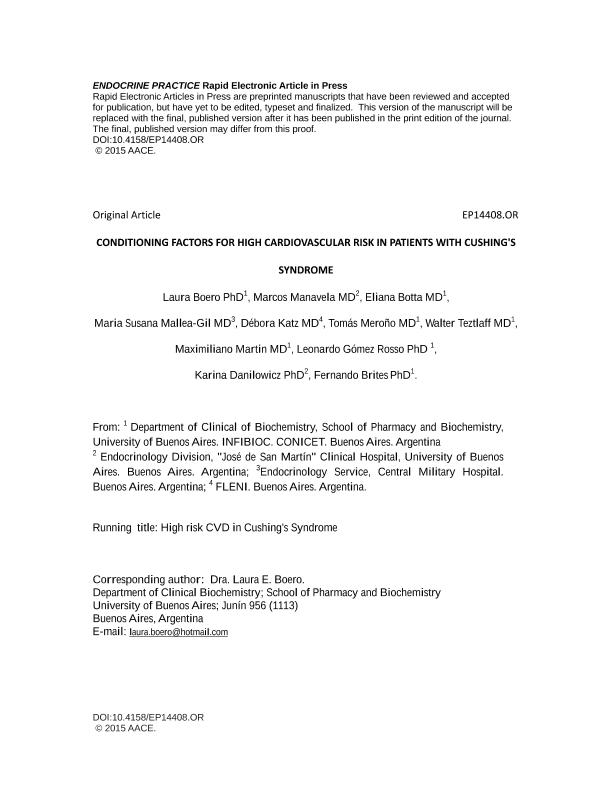Artículo
Conditioning Factors for High Cardiovascular Risk in Patients with Cushing's Syndrome
Boero, Laura; Manavela, Marcos; Botta, Eliana Elizabeth ; Mallea Gil, Maria Susana; Katz, Débora; Meroño, Tomás
; Mallea Gil, Maria Susana; Katz, Débora; Meroño, Tomás ; Tetzlaff, Walter Francisco; Martin, Maximiliano Emanuel
; Tetzlaff, Walter Francisco; Martin, Maximiliano Emanuel ; Gomez Rosso, Leonardo Adrián
; Gomez Rosso, Leonardo Adrián ; Danilowicz, Karina; Brites, Fernando Daniel
; Danilowicz, Karina; Brites, Fernando Daniel
 ; Mallea Gil, Maria Susana; Katz, Débora; Meroño, Tomás
; Mallea Gil, Maria Susana; Katz, Débora; Meroño, Tomás ; Tetzlaff, Walter Francisco; Martin, Maximiliano Emanuel
; Tetzlaff, Walter Francisco; Martin, Maximiliano Emanuel ; Gomez Rosso, Leonardo Adrián
; Gomez Rosso, Leonardo Adrián ; Danilowicz, Karina; Brites, Fernando Daniel
; Danilowicz, Karina; Brites, Fernando Daniel
Fecha de publicación:
07/2015
Editorial:
American Association of Clinical Endocrinologists
Revista:
Endocrine Practice
ISSN:
1530-891X
Idioma:
Inglés
Tipo de recurso:
Artículo publicado
Clasificación temática:
Resumen
Objective: To characterize the alterations in carbohydrate and lipoprotein metabolism, to evaluate markers of lipoprotein functionality, and to identify the presence of novel atherogenic risk factors in patients with Cushing syndrome (CS) in comparison with sex- and age-matched controls.
Methods: In an open, cross-sectional study, 32 nontreated patients with active CS were consecutively recruited from the Endocrinology Service at “José de San Martín” Clinical Hospital, University of Buenos Aires, Argentina, between April 11, 2010 and December 11, 2012. The patients were compared with sex- and age-matched controls.
Results: Versus controls, patients with CS presented with excess weight, central obesity, and hypercortisolism. They also exhibited an insulin-resistant state, with high resistin levels (median [interquartile range], 16 [10 to 22] ng/mL versus 6 [5 to 9] ng/mL; P<.0001), a more atherogenic lipoprotein profile, high oxidized low-density lipoprotein levels (oxLDL; mean ± SD, 100 ± 31 U/L versus 75 ± 32 U/L; P<.05) and high sensitive C-reactive protein levels (median [interquartile range], 1.2 [0.6 to 3.1] mg/L versus 0.6 [0.3 to 1.1] mg/L; P<.05), and increased leukocyte count (mean ± SD, 9.5 ± 2.6 × 103 cells/μL versus 6.5 ± 1.4 × 103 cells/μL; P<.0001). Multivariate analyses showed that the increase in waist circumference was associated with both the diagnosis of CS and the degree of insulin resistance. Resistin concentration was related to a greater extent to the diagnosis of CS than to homeostasis model assessment–insulin resistance. Triglyceride and oxLDL levels were only significantly associated with the diagnosis of CS.
Conclusion: Hypercortisolism is related to the increase observed in triglycerides and oxLDL levels, and, in combination with insulin resistance, acts to increase waist circumference and amplify the inflammatory process, key factors for the development of cardiovascular disease.
Palabras clave:
Cushing'S Syndrome
,
Cardiovascular Risk
,
Hypercortisolism
,
Oxidized Ldl
Archivos asociados
Licencia
Identificadores
Colecciones
Articulos(OCA HOUSSAY)
Articulos de OFICINA DE COORDINACION ADMINISTRATIVA HOUSSAY
Articulos de OFICINA DE COORDINACION ADMINISTRATIVA HOUSSAY
Citación
Boero, Laura; Manavela, Marcos; Botta, Eliana Elizabeth; Mallea Gil, Maria Susana; Katz, Débora; et al.; Conditioning Factors for High Cardiovascular Risk in Patients with Cushing's Syndrome; American Association of Clinical Endocrinologists; Endocrine Practice; 21; 7; 7-2015; 734-742
Compartir
Altmétricas



